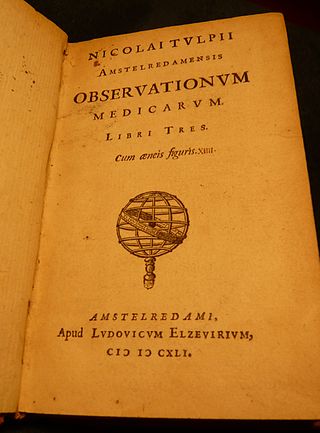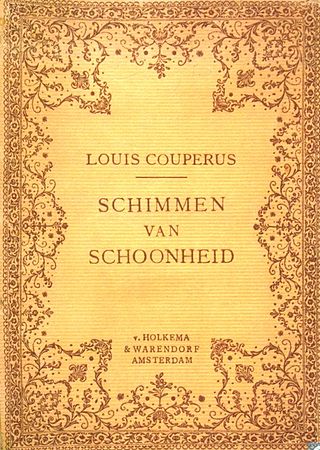

As of 2018, Wolters Kluwer ranks as the Dutch biggest publisher of books in terms of revenue. [2] [3] [4] Other notable Dutch houses include Brill (est. 1683) and Elsevier (est. 1880). [5]


As of 2018, Wolters Kluwer ranks as the Dutch biggest publisher of books in terms of revenue. [2] [3] [4] Other notable Dutch houses include Brill (est. 1683) and Elsevier (est. 1880). [5]
Printed books first appeared in the 1470s in places such as Delft, Deventer, Gouda, Nijmegen, Utrecht, Zwolle, and in the 1480s in places such as Haarlem, Leiden, and 's-Hertogenbosch. [6] [7]
Among Dutch bestsellers are titles such as the 17th-century Lusthof des Gemoets by Jan Philipsz Schabaelje. [8] [9]
The Stichting Drukwerk in de Marge formed in 1975, and organizes an annual Boekkunstbeurs (book fair). [10] Bibliophiles in 1991 organized the Nederlands Genootschap van Bibliofielen. [11]
The United Nations Educational, Scientific and Cultural Organization named Amsterdam the 2008 World Book Capital.
The Leiden University Library began in 1575, and the Koninklijke Bibliotheek (royal library) in The Hague in 1798. Since 1919, the Nederlandse Centrale Catalogus lists titles in Dutch libraries.

The NIOD Institute for War, Holocaust and Genocide Studies is an organisation in the Netherlands which maintains archives and carries out historical studies into the Second World War, the Holocaust and other genocides around the world, past and present. The institute was founded as a merger of the Netherlands Institute for War Documentation and the Center for Holocaust and Genocide Studies (CHGS).

Lodewijk Elzevir, originally Lodewijk or Louis Elsevier or Elzevier, was a printer, born in the city of Leuven. He was the founder of the House of Elzevir, which printed works such as "Two New Sciences", written by Galileo, at a time when his work was suppressed for religious reasons. Although the House of Elzevir ceased publishing in 1712, the modern Dutch Elsevier company was founded in 1880 and took its name from the historic Dutch publishing house.

Leiden University Libraries is a library founded in 1575 in Leiden, Netherlands. It is regarded as a significant place in the development of European culture: it is a part of a small number of cultural centres that gave direction to the development and spread of knowledge during the Enlightenment. This was due particularly to the simultaneous presence of a unique collection of exceptional sources and scholars. Holdings include approximately 5,200,000 volumes, 1,000,000 e-books, 70,000 e-journals, 2,000 current paper journals, 60,000 Oriental and Western manuscripts, 500,000 letters, 100,000 maps, 100,000 prints, 12,000 drawings and 300,000 photographs. The library manages the largest collections worldwide on Indonesia and the Caribbean. Furthermore, Leiden University Libraries is the only heritage organization in The Netherlands with five registrations of documents in UNESCO's Memory of the World Register.

Hossein Sadjadi Ghaemmaghami Farahani, better known by his pen name Kader Abdolah, is an Iranian-Dutch writer, poet and columnist. His books, written in Dutch, often contain Persian literary themes. He regularly appears on Dutch television as well.

DPG Media Group is a Belgian media company also active in the Netherlands and Denmark. It is owned by the Van Thillo family and employs some 6,000 people.

Leonard Salomon Ornstein was a Dutch physicist.
The Gouden Ganzenveer is a Dutch cultural award initiated in 1955, given annually to a person or organization of great significance to the written and printed word. Recipients are selected by an academy of people from the cultural, political, scientific, and corporate world. Members meet once a year; the winner is announced each year in January and honored in April. From 1995 to 1998 the award was granted by the Koninklijke Nederlandse Uitgeversbond, the Royal Dutch Organization of Publishers; since 2000, it is granted by a separate organization.
In the Netherlands, the Boekenweek is an annual "week" of ten days dedicated to Dutch literature. It has been held in March annually since 1932. Each Boekenweek has a theme. The beginning of the Boekenweek is marked by the Boekenbal, a gathering that is attended by writers and publishers. Events are held across the country during the Boekenweek, such as book signing sessions, literary festivals and debates.
Jacoba van Velde was a Dutch writer, translator, and dramaturge. Her first novel, De grote zaal, appeared in the literary journal Querido in 1953 and was translated into thirteen languages within ten years. During her life around 75,000 copies of De grote zaal were sold. In 2010, the book was chosen for the Nederland Leest campaign and copies were given away for free to members of all the public libraries in The Netherlands.
Jacobus Ruurd "Jaap" Bruijn, was a Dutch maritime historian. He was professor of maritime history at the University of Leiden from 1979 until his retirement in 2003. During his 41-year teaching career as The Netherlands' only university professor of maritime history, he guided the doctoral theses of at least 49 graduate students.
The Collectieve Propaganda van het Nederlandse Boek is a Dutch organization that includes representatives of bookstores and publishers, whose goal is to promote Dutch literature.

Pieter Mortier, or Pierre Mortier as the publisher of books in French, was the name of three successive generations of booksellers and publishers in the Dutch Republic.

Petronella Moens was a blind Dutch writer, editor, and feminist. She managed a paper in 1788–1797, in which she spoke for political issues such as slavery and women suffrage.

Schimmen van schoonheid is a collection of short stories, written by Louis Couperus and published by Van Holkema & Warendorf in 1912. It is not known how many copies were printed for the first edition, but this edition was in any case sold out by 1929. The second edition was published in 1962 by Querido in the so-called Salamander series.

Arendo Joustra is a Dutch writer and journalist.
Hans Renders is a professor of history and biography theory at the University of Groningen. Since 2004, he is also the head of the university's "Biography Institute".
Judith Maria Ten Bosch is a Dutch painter and illustrator.
Hendrik Klaas Aldert"Henk"Visser was a Dutch pediatrician. He was professor of pediatrics at the Erasmus University Rotterdam and the Erasmus MC between 1967 and 1995.

Arie Abraham (Ary) Kampman was a Dutch scholar of Ancient Near Eastern studies, an initiator of scholarly societies and journals, and a secondary school teacher. Kampman obtained his Dutch PhD degree with professor Frans de Liagre Böhl on the 1945 thesis De historische beteekenis der Hethietische vestingbouwkunde. In 1939 he was a founder of the Nederlands Archaeologisch Instituut voor het Nabije Oosten, the predecessor of the present The Netherlands Institute for the Near East.

Franz "Frans" Marius Theodor de Liagre Böhl was a Dutch professor of Assyriology and Hebrew.
Welke sedert het jaar 1790...1831, in Noord-Nederland zijn uitgekomen
{{cite book}}: CS1 maint: location missing publisher (link){{cite book}}: CS1 maint: location missing publisher (link)